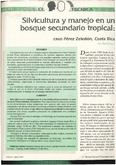| dc.contributor.author | Hutchinson, Ian | |
| dc.contributor.other | CATIE – Centro Agronómico Tropical de Investigación y Enseñanza | es_ES |
| dc.date.accessioned | 2015-03-11T21:13:06Z | |
| dc.date.available | 2015-03-11T21:13:06Z | |
| dc.date.issued | 1993-02 | |
| dc.identifier.issn | e-ISSN: 1021-0462. | es_EN |
| dc.identifier.uri | https://repositorio.catie.ac.cr/handle/11554/5719 | |
| dc.description | 6 páginas. 3 ilustraciones, 9 referencias, 4 tabulaciones. | es_ES |
| dc.description.abstract | Este estudio de caso en un bosque natural secundario en Pérez Zeledón (Costa Rica) demuestra la presencia de muchas especies nativas con grados de crecimiento competitivo con aquellas especies exóticas plantadas comúnmente en América Central. Dicho bosque, no mayor de 40 años de edad, responde positivamente al manejo silvicultural y muestra una
excelente capacidad para un sostenido y lucrativo manejo forestal. Los ingresos por la venta de trozas para el aserrío y entresacas para leña, exceden el costo del tratamiento.
El tratamiento actual duplica la extracción de madera por encima de un límite de corta de 50 cm dap con liberación de troncos seleccionados con diámetros entre 10-49 cm dap.
El manejo aumenta la intensidad de iluminación de la copa de las especies ~eleccionadas , duplicando el incremento diamétrico promedio de tales árboles. Los resultados obtenidos son valiosos para la toma de decisiones en cuanto al uso de la tierra; ofreciendo dentro del mismo, sostenibilidad
económica para el manejo de un bosque natural tropical. | es_ES |
| dc.description.abstract | This case study in a natural secondary forest demonstrates many indigenous tree species with rates of growth
competitive with those 01 exotics commonly planted in Central América, and a lorest not yet 40 years 01 age which is responding positively to silvicultural treatment and shows excellent prospects lor sustainable and prolitable lorest management. Income Irom the sale 01 sawlogs and thinnings as lirewood exceeds the cost 01 treatment. The current treatment couples a selective logging 01 trees larger than a
minimum cutting limit 01 50 cm dbh with a liberation 01 selected stems in the diameter range 10-49 cm dbh. The treatment increases the intensity 01 illumination 01 the crowns 01 the selected trees, almost doubling the rate 01 diameter growth 01 those same trees. Changes in Iloristic composition, estimated by the relative presence 01 botanical lamilies, lall within acceptable limits. Such lindings are valuable lor decisions on land use, and within the economic Iramework 01 holdings which carry natural lorest. | en_EN |
| dc.language.iso | es | es_ES |
| dc.publisher | CATIE, Turrialba (Costa Rica). Proyecto Producción en Bosques Naturales. | es_ES |
| dc.relation.ispartof | Revista Forestal Centroamericana. Volumen 2, número 2 (febrero- abril 1993), páginas 13-18 | |
| dc.rights | info:eu-repo/semantics/openAccess | |
| dc.subject | SILVICULTURA | es_ES |
| dc.subject | MANEJO FORESTAL | es_ES |
| dc.subject | BOSQUE SECUNDARIO | es_ES |
| dc.subject | BOSQUE NATURAL | es_ES |
| dc.subject | UTILIZACION FORESTAL | es_ES |
| dc.subject | SOSTENIBILIDAD | es_ES |
| dc.subject | LISTAS DE ESPECIES VEGETALES | es_ES |
| dc.subject | PERTURBACIONES ANTROPOGENICAS | es_ES |
| dc.subject | COSTA RICA | es_ES |
| dc.subject | SILVICULTURE | es_ES |
| dc.subject | SECONDARY FORESTS | es_ES |
| dc.subject | SUSTAINABILITY | es_ES |
| dc.subject | SYLVICULTURE | es_ES |
| dc.subject | FORET SECONDAIRE | es_ES |
| dc.title | Silvicultura y manejo en un bosque secundario tropical: caso Pérez Zeledón, Costa Rica | es_ES |
| dc.type | Artículo | es_ES |


